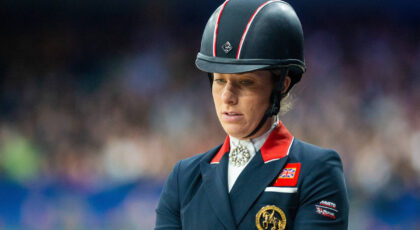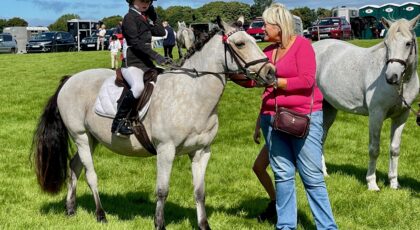For those of us in the Northern Hemisphere, November is far from the most heinous month of the calendar year.
February, for instance, is arguably much worse with its modest temperature averages and impressive ‘frozen precipitation’ index. (I’m from Syracuse, New York; we don’t say the ‘S’ word around here). But somehow, November just hits different.
Like, yes, I could be doing laundry, paying bills, and finishing my workday to-do list so I can get to the barn and ride… OR… I could continue eating this half-box of Triscuits under my chenille blanket in front of the roaring gas fireplace for the next four hours. Really, it’s anybody’s guess.
But if you, like me, find that diligently maintaining your Type-A riding mentality through this very-definite change in seasons is an exercise in self-discipline worthy of an 18th century samurai, you’re not alone.
In addition to falling temps, wintertime makes horses fresher, hairier, and harder to keep clean and cool out—none of which is particularly fun times from the rider’s perspective. With show season over, many of us have put our ambitions squarely on the back burner until the thaw. And even for those planning to compete at winter venues down South (or West), show season is still very far away.
Having ridden through Northeast winters for the better part of 30 years, I’d like to share a few tricks I’ve gleaned for beating “Seasonal Equestrian Disorder” during these trying months. The goal? Making barn time enjoyable again, no matter how many sub-40-degree days are in our future.
First, the medical
‘Seasonal Equestrian Disorder’ is annoying, to be sure, but Seasonal Affective Disorder (SAD) is real—and it can be serious.
If you think you could be one of the 5% of adults in the U.S. that are suffering from the condition, or the additional 10% dealing with subsyndromal SAD—where you suffer from SAD symptoms but don’t meet the criteria for clinical depression—talk to your doctor or a mental health professional. There are things you can do to help.
(Key stat for my ladies: women are three times more likely to suffer, especially those of us who live in the Northern U.S. and Canada).
Having done my own therapy due diligence this year, I’m managing the onset of my own minor symptoms this month with some at-home bright light treatment. And though it’s only been a week so far, I’m already feeling a difference in my energy-level and mood—essentials when it comes to getting off the couch and getting my butt to the barn.
The key when selecting a light is a 10,000-lux rating, which measures its intensity; the Verilux Happy Light ($60) is one well-rated choice.
Think like a horse
Winters can be long, indoors arenas can be small, and it’s more than likely that your horse will become as bored and uninspired by his indoor environs as you are.
Consider setting a weekly schedule to keep both of you on task, while also keeping you varying tasks—perhaps a couple of days a week of flat/fitness work or “happy hacking,” a day of jumping or more serious training (read on for a list of exercises), a day of tack-walking, and/or a “fun day” to get you both out of your comfort zones.
Depending on your horse (and in consultation with your trainer, of course), you might consider dabbling in a different discipline, riding bareback or with a rope around the neck in place of a bridle, clicker training, or working on groundwork at liberty or with a rope halter.
And—it goes without saying—keep an eye on the weekly weather forecast for any opportunities for you and your horse to get outside and soak up a little sun during a snowy trail ride or a short hand-graze.

Layer-up
Did you know there’s a right and a wrong way to layer? How you dress can have a big impact on your overall comfort at the barn and how willing you are to brave the cold for extended periods.
As a first step, investing in a quality base layer that incorporates Merino wool—which is naturally breathable, odor-resistant, and moisture-absorbing—is a must. Similarly, Smartwool ski socks (from $27) are great underneath boots and can be a life-saver for your feet.
Next, add a mid-layer (think: a fleece or a thin down puffy) under your heavy winter coat, which can stand on its own on more moderate days, or when you’re working up a sweat in the saddle.
Finally, for extra chilly rides, you can’t beat a pair of insulated paddock boots and chaps (oh hey, full chaps, they’re back!) over a pair of fleece-lined jeans. In my opinion, L.L. Bean’s classic version ($89) are worth the splurge. And if you’re truly desperate, make like a Buffalo Bills fan and invest in a heated vest, which can keep your core toasty for hours at a time.
Get goal-ing
Forget a lack of blue ribbons… in my experience, nothing crushes a rider’s overall motivation faster than a lack of goals. While it can be easy to think of wintertime as a step back from horse showing or serious outdoor training, just the opposite can be true.
Use the off-season as an opportunity to step up your game. That could mean concentrating on yourself so you can break some long-lingering bad habits, improving your seat and position, developing the bond with your horse, bringing along a green project, or simply keeping your skills sharp between stints at circuit.
Not everyone needs to earn their gold star during #NoStirrupNovember, but you can use the fall-to-winter months to improve your horse’s canter, achieve better balance over jumps, master trot fences, and so much more.
Me? Having learned a thing or two about riding with straightness this summer (and my general lack of it), I’m going to work on not hijacking the left rein this season at all gaits and while turning to fences, despite the added challenge of riding in a small, indoor ring.
Then, when summer comes, I plan to hit the (outdoor arena!) ground running.




 November 23, 2023
November 23, 2023 




























